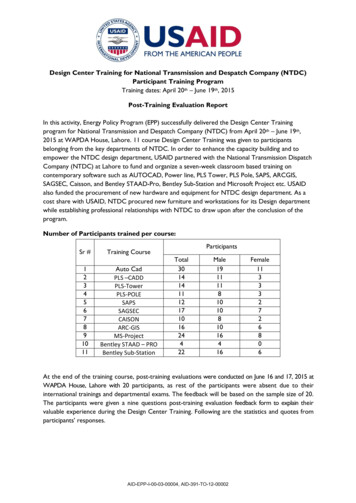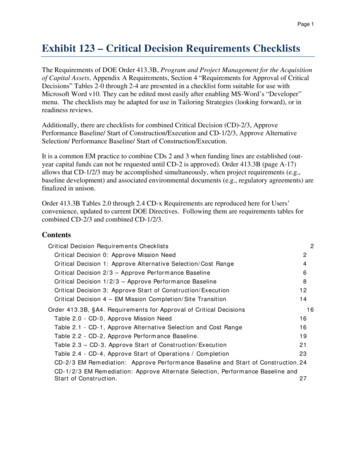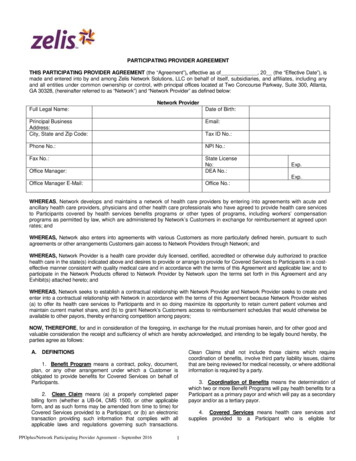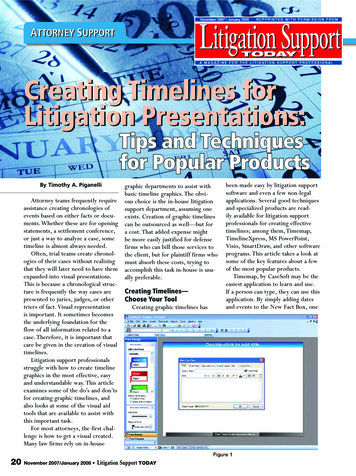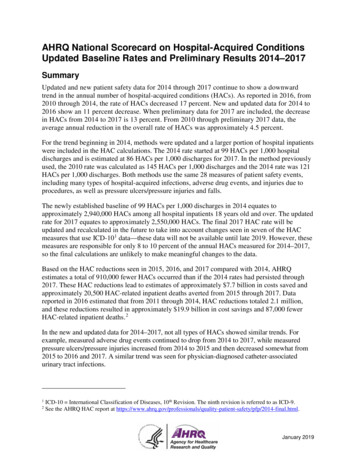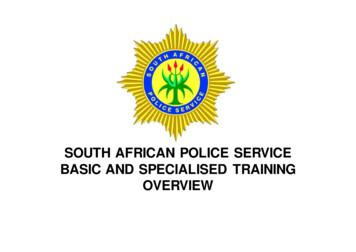
Transcription
SOUTH AFRICAN POLICE SERVICEBASIC AND SPECIALISED TRAININGOVERVIEW
The Vision of the SAPS:Human ResourcesDevelopment Division“To ensure quality education, trainingand development (ETD) in support ofcreating a safe and secureenvironment for all people in theRepublic of South Africa.”
The Mission of the SAPS:Human ResourcesDevelopment Division“To invest in human capital throughinnovative and quality education, trainingand development (ETD) of all employeesof the South African Police Service,promoting lifelong learning, in support ofeffective service delivery.”
Intensity andskillsTraining intensity and skill level escalates as thethreat level increasesBasic POPK9TRTNIUSTFHighLow
Public order operations Crowd management Restoring public unrest Restoring serious publicviolenceMedium-risk operations Rapid response operations Arrest warrants with a mediumthreat Search warrants with mediumdifficultyPOPHigh-risk operations CIT (open-air robberies) Barricaded suspects Dangerous arrest warrants Dangerous/difficult searchwarrantsSpecialisedoperations:International andnational interesthostage releaseandcounterterrorismNIUSTFTRTCourtesy: Lt Col Scott, STF
BASIC POLICE DEVELOPMENTLEARNING PROGRAMME
BASIC POLICEDEVELOPMENTSOUTH AFRICAN POLICESERVICE
THE PURPOSE OF BASIC POLICETRAININGTo enable newly appointed police officials to ––use a series of legal and policing skills to protect and servemembers of communities in terms of the Constitution ofSouth Africa, 1996 (Act No 108 of 1996).–provide a more effective service, which will improvecommunity satisfaction and put them in a position to fulfiltheir mission of creating a safe and secure environment forall who live in South Africa.8
EXIT LEVEL OUTCOMESOn completion of this basic training, the learner will be able to 1. balance the constitutional and legal rights of individuals withthe competence to legally infringe those rights in the serviceof maintaining a safe and secure society.2. evaluate policing principles and their application in relation tocrime prevention.3. conduct a criminal investigation by gathering information andevidence.4. evaluate situations and select tactical techniques and skillsneeded to perform policing duties and maintain the safety ofthe self and others.9
EXIT LEVEL OUTCOMES (continued)5. support a criminal prosecution by preparing documentsand giving evidence in a court of law.6. apply the principles of operation and service deliverywithin a Client Service Centre (CSC) in a policingenvironment.7. maintain professional conduct to enhance the principlesof service delivery to the community.10
BASIC POLICE DEVELOPMENTThe target group for Basic Police Development’sentry-level recruits are constablesThe duration of the learning programme: 24 months Academy phase- 12 months Workplace learning phase - 12 months
LEARNING AREAS OF THE BTLPLA 1: Orientation to the SAPSLA 2: LawLA 3: Community Service CentreLA 4: Crime InvestigationLA 5: Crime PreventionLA 6: Street Survival12
THE PURPOSE OF LEARNING AREA 1To orientate the learner on how to conducthimself/herself in a professional manner in apolicing environment and to introduce theSAPS culture to the learners.13
BASIC POLICE DEVELOPMENTLearning Area 1: Orientation to the SAPSTrainees are trained in professional conduct, includingdiscipline, command and control, and team work.Employee Health and Wellness(EHW) is also addressed toenable the trainees to cope with the stressful situations they areto be confronted with as they perform their duties.EHW has a module that particularly deals with selfmanagement and anger management.Human Rights forms a golden thread in the programme and ispresented in all the learning areas.
BASIC POLICE DEVELOPMENTLearning Area 2: LawFocusing on equipping the trainees with aspects of law,particularly Criminal Law.The Criminal Procedure Act, 1977 (Act No 51 of 1977) ispresented.Issues related to effecting an arrest are dealt with in alllearning areas.The use of force and how to effect an arrest in terms ofSection 49(2) of the Criminal Procedure Act, 1977 (Act No51 of 1977) are dealt with extensively.
BASIC POLICE DEVELOPMENTLearning Area 6: Street SurvivalThe use of force is also addressed when firearm and tactical training arepresented to the trainees.Exercising alertness during policing tasks to ensure the safety of policeofficials and the public through preventative actions.Exercising initiative and tactical preparation during policing tasks.Understand techniques of tactical communication.Use personal equipment safely to ensure safe and lawful performance ofpolicing tasks.Make ‘use of force’ tactical decisions that meet legal and organisationalrequirements.Apply the principles of the use of force to ensure safe and lawfulperformance of policing tasks.
BASIC POLICE DEVELOPMENTFirearm training is presented throughout the training in terms of theFirearm Control Act, 2000 (Act No 60 of 2000).All trainees are trained in the safe handling and practical shooting ofthe following firearms: 9mm pistol, an R5 rifle and a shotgun.The general aspects applicable to all firearms are dealt with in thetraining, as well as the fundamentals of shooting.Trainees are exposed to tactical and street survival techniques, tacticalaspects with regard to tactical awareness, the carrying of firearms incertain situations and conditions of firearms, when attending tocomplaints.
BASIC POLICE DEVELOPMENTCrowd Management is presented theoretically in the programme.The Crowd Management presented at this level is for the firstresponders in crowd management before specialised trained membersarrive.Explain the relevant legislation/legal aspects of crowd management.Report crowd forming and actions by the first member(s) in the crowdthat is developing.Explain the first police member’s/members’ responsibilities at thescene of the spontaneous gathering.Explain crowd dynamics.Explain the use of force in crowd management operations.
BASIC POLICE DEVELOPMENTIn Crowd Management, the trainees are also trained tounderstand the relevant legislation.The Regulations of Gatherings Act, 1993 (Act No 205 of1993) together with SO (G) 262 are discussed with thetrainees.A reference is also made to sections 10, 11, 12 , 16, 17, 18and 36 of the Constitution, which refers to the right tohuman dignity (section 10), the right to life (section 11) ,the right to freedom of expression (section 12,16), the rightto assemble, demonstrate, picket and hand over petitions(section 17), the right to association (section 18) andlimitation of the rights (section 36).
PRACTICAL SHOOTING During the workplace learning phase, physicalfitness and shooting practise on all firearmsare undertaken. If levels decline, trainees are given remedialtraining on the specific problem areas throughcoaching.
PUBLIC ORDER POLICEESTABLISHMENT AND TRAINING
“The Constitution of the Republic of South Africa,1996 (Act No 108 of 1996)” The right to the existence of the Public Order Police units is founded inthe Constitution. In terms of section 17(1) of the South African Police Service Act, 1995(Act No 68 of 1995), the National Commissioner will, subject to section218 (1)(K) of the Constitution, establish and maintain a national publicorder capacity.
The mandate of Public Order Policing is toprovide security and stabilise solutions forcrowd management and crowd unrestsituations, where classic policing strategies arenot equipped to deal with the situation.
ADMINISTRATIVE POLICY: DIVISION VISIBLE POLING : THEFUNCTIONINGOF PUBLIC ORDER POLICE (POP) 3/1/5/1/174 dd 200811-18 Responsible for maintaining Public Order performing crowd management combating public violence stabilizing of serious and violent crime incidents giving specialised operational support The rendering of specialised assistance to Divisions, iedetectives, border police and VIP Protection
CROWD MANAGEMENTCURRICULUMPlatoon membersThe Crowd Management curriculum consists of the following fivemodules and is presented over 3 weeks:Module 1: Legal FrameworkModule 2: Preparing for Crowd Management IncidentsModule 3: Crowd Management EquipmentModule 4: Crowd Management TechniquesModule 5: Crowd Management Operations
Module 1: Legal Framework The Constitution of the Republic of South Africa, 1996 (Act No 108of 1996), the South African Police Service Act, 1995 (Act No 68 of1995) The Regulation of Gatherings Act, 1993 (Act No 205 of 1993) SO (General) 262Module 2: Preparing for Crowd Management Incidents Crowd dynamics Conflict resolution Scale of use of force Constitutional powers of the police Deadly force Tactical communication Equipment and use of resources
Module 3: Equipment Helmet Gas mask and filter Body armour Tonfa Shield Musler shotgun and double-ball rubber rounds Pepper spray CS (tear gas) – CS rifle grenades and 40mm CS rounds Stun grenades Other pyrotechnical aids (coloured smoke grenades, flares) B&T 40mm grenade launcher
Module 4: Crowd Management Techniques Techniques on footPlatoon and section formationsIndoor techniquesVehicle formationsPrincipals and rules of intervention Legality Optimisation (optimal use of equipment) Situational appropriateness (my actions must solve theproblem, not create a bigger one) Proportionality (are my actions proportional to the threat) Shooting range – shotgun with double-ball rubber rounds Tactical options DefensiveOffensive Block protestorsSearch IsolatePushback ChanneliseEvacuate EscortEncircle PatrolDisperse
Module 5: Crowd Management Operations Definitions and abbreviations of crowd management Conventional signs related to crowd management Briefing and debriefingAssessmentFormative and summative assessments are used to assess theunderstanding of the course content, application of the knowledgeand behavioural change of the learners.
K9 DOG HANDLERS
INTRODUCTION The safety and security of all inhabitants of ourcountry is the responsibility of the South AfricanPolice Service (SAPS). This includes the deterrence of crime, theinvestigation of all crimes and participation, ineffect, to establish the root causes of crime. Police dogs are a huge aid in this regard.
THE TRAINING OF POLICE DOGSPatrol Dog Handlers Training Course (four months) and Tactical Dog Handlers Course (three weeks)Sniffer and Specialised Dog Handlers Training Course (five months) and Tactical Dog Handlers Course (two weeks)
PATROL DOG HANDLERS TRAININGCurriculum Obedience Apprehending armed/dangerous suspects Searching for suspects in an open area orbuildings Averting an attack Practical tracking Searching for articles Retrieving an object
PATROL DOGS ARE TRAINED TO - follow a human trail and indicate whatobjects contain a human scent at a crimescene. apprehend fleeing, dangerous, armedsuspects and find possible scented objects. avert and apprehend dangerous, armedsuspects.
THE OPERATIONAL DEPLOYMENT OFPATROL DOGS Patrol dog handling teams can be deployed to acrime scene at the request of any member of theSAPS, station or unit or any investigating officer,to assist with the investigation. Patrol dogs can be used to prevent, combat andinvestigate crime.
SNIFFER AND SPECIALISED DOGHANDLER TRAININGCurriculum Obedience Searching for substance(s) in vehicles,buildings, containers, under ground andpavilions. Searching for substance(s) in open areas.
THE OPERATIONAL DEPLOYMENT OFSNIFFER AND SPECIALISED DOGS The K9 handler and sniffer dogs and specialiseddogs can be deployed to a crime scene at therequest of any SAPS member, station or unit orany investigating officer to assist with theinvestigation. The K9 handler and sniffer or specialised dog canbe deployed to a crime scene, any operation,roadblock, ports of entry and any crossinternational border at the request of anyinvestigating officer or Department of ForeignAffairs, to assist with an investigation.
TACTICAL DOG HANDLERS COURSE:BACKGROUND After the Jeppe Town incident on 25 June 2005,the Crime Prevention Division conducted a skillsaudit on the tactical training standards of dog unitsand members of the Flying Squad. Divisional Commissioner AH Lamoer (letter:11/1/3/1/2817: 11/1/3/12925 dated 20 October2006) indicated that tactical training had to bepresented to candidate handlers in their basic doghandler courses.
TACTICAL DOG HANDLERS COURSE:TRAINING MODULESTheoretical presentationsLegal aspects Private defence Use of force (section 49 of the CriminalProcedure Act, 1977 (Act No 51 of 1977)) Search and seizureSeven survival principlesTactical procedures
TACTICAL DOG HANDLERS COURSE:TRAINING MODULESWeapon‐handling skills Shooting fundamentals Safe direction Safe making, loading, assembling anddisassembling a 9mm handgun, an R5assault rifle and a Musler shotgun. The carrying conditions and the shootingpositions of a 9mm handgun, an R5 assaultrifle and a Musler shotgun.
TACTICAL DOG HANDLERS COURSE:TRAINING MODULESTactical movement Primary position Step-by Buttonhook penetration technique Two-man door penetration technique, with andwithout a dog Hi-lo, with and without a dog Passage movement, with and without a dog Stair movements, with and without a dog Room clearing techniques, with and without a dog
TACTICAL DOG HANDLERS COURSE:TRAINING MODULES CONTINUED Various tactical movements for target approach Climbing techniques Handling suspicious persons, as well as vehicles Arresting techniques Ambush spoor Close Quarter Combat
TACTICAL DOG HANDLERS COURSE:SHOOTING EXERCISES Standard maintenance shooting exercise- 9mm handgun – 5 m to 15 m- R5 assault rifle – 30 m- Shotgun – 10 m (baton rounds) Assault courses- Move from firing line to firing line to engage targets/2 m to 10 m away Stop-Street-Ambush- Shooting exercise with the dog- Send the dog on a suspect to apprehend the suspect while handlersengage other targets
TACTICAL DOG HANDLERS COURSE:SHOOTING EXERCISES Jungle lane- The shootist moves in a predefined path from point A to point B andengage 10 targets with his/her shotgun (baton rounds) Close Quarter Combat shooting exercise- The shootist will apply all striking as well as kicking techniques on aprotection pad and engage targets with a firearm. Charge office blue- The shootist will sit behind a table, assemble a 9mm handgun andengage targets while moving from firing point to firing point.
TACTICAL DOG HANDLERS COURSE:REFRESHER COURSES The Tactical Dog Handlers Course is valid forthree years. After three years, the dog handler must attenda Tactical Dog Handlers Refresher Course.
TRAINING AT K9 UNITS Each K9 Unit will have a dog exercise sessiononce a week. In this exercise session, the dog will be trainedin al disciplines to ensure that the dog, as wellas the handlers, adhere to the standards set bythe National Instruction. During this exercise session, practical exercisescenarios will be presented to the handler andthe dog.
TRAINING AT K9 UNITS CONTINUED K9 handlers can attend as many possibleshooting practices as they can in a year. K9 handlers must attend onemaintenance shooting exercise per year.
TACTICAL RESPONSE TEAMSESTABLISHMENT AND TRAINING
INTRODUCTION“Proposed model: Tactical Response Team. 11/1/1dated 8 September 2009” It was established in October 2009 on theinstruction of the National Commissioner. Purpose To increase tactical capacity at cluster level tosupport clusters in dealing with medium-riskoperations.
“Establishment of Tactical ResponseDocument 3/1/5 dated 1 April 2010”EquipmentEquipmentBallistic helmetTactical glovesTactical gogglesEquipment bagTactical vestBullet-resistant vestTactical belt9mm pistolUtility leg rigR5 assault rifleLeg holsterStun grenadeKnee and elbow padsSmoke grenadeBlue police beretJump suitTeams
“Draft National Instruction: EstablishmentFunctioning of Tactical Response Team Units”andThe mandate of the tactical response teams is to providea tactical solution to medium threat situations, wheregeneric policing strategies are not equipped to deal withthe situation.
“Draft National Instruction: EstablishmentFunctioning of Tactical Response Team Units”andThe TRT renders a tactical support function to clusterbased, medium threat, intelligence-driven operations anda quick reaction capability to serious and violent crime tocontain the situation until the NIU/STF’s tactical unitsarrive.orReact, if necessary, if a tactical solution cannot bedelayed.
“Draft National Instruction: EstablishmentFunctioning of Tactical Response Team Units”1.Combating crime focuses on (a)providing an immediate tactical responsecapacity within an identified cluster area;(b)addressing crime through well-planned,intelligence-driven operations or specificrequests within an identified cluster area.and
“Draft National Instruction: EstablishmentFunctioning of Tactical Response Team Units”2.Combating public violence by (a)rendering support to major events(b)restoring public order(c)supporting the Public Order Police incombating crowd management.and
“Draft National Instruction: EstablishmentFunctioning of Tactical Response Team Units”3.4.5.6.Escorting dangerous criminals.Escorting valuable and/or dangerous cargo.Providing tactical assistance to other units within thecluster areas.Rendering support during disasters and incidentmanagement.and
“Draft Divisional Directive: TRT Recruitment andSelection”Preselection profile1.2.3.Applicants must have a minimum of two years’functional experience after completing basic training.Applicants must be medically fit and willing to undergoan extensive medical evaluation.Only functional members appointed in terms of Section5 of the South African Police Service Act, 1995 (Act No68 of 1995) with the rank of Constable, Sergeant,Warrant Officer and Lieutenant/Captain can apply.
“Draft Divisional Directive: TRT Recruitment andSelection”Preselection profile4. Applicants must be willing to undergo a psychometricevaluation and fit the TRT competency profile.5. Applicants must be willing to undergo and be successful infitness and shooting evaluations.6. Applicants must not have been found guilty of any criminal ordepartmental contravention.7. Applicants must not be declared unfit to possess a firearm orbe subjected to a Section 102 investigation.
“Draft Divisional Directive: TRT Recruitment andSelection”Preselection profile8. Applicants must be in possession of a valid code (EB) driver’slicence.9. Applicants must not be older than 28 years on the day of therespective closing date for applications.10. Applicants must be willing to attend and successfully completethe prescribed Tactical Response Team’s training cycle.
“Draft Divisional Directive: TRT Recruitment andSelection”Minimum selection criteriaSelection process: Application Psychometric evaluation Preselection fitnessevaluation Preparation and conditioning Medical examination Baseline evaluationsAverage selection success rate Applications: 550 Psychometric evaluations: 330 Preselection fitness: 120 Prepcon: 35 Baseline evaluations: 25
“Draft Divisional Directive: TRT Recruitment &Selection”Selection criteria PreselectionApplicationPsychometric evaluation since April 2011Fitness evaluationMedical examination
“Draft Divisional Directive: TRT Recruitment andSelection”Baseline evaluations Fitness Endurance testing Upper body strength Agility Shooting 9mm pistol R5 assault rifleBaseline Assessment ToolFitness 2,4 km run Push-ups Sit-ups Bench dips Shuttle runsShooting 9mm pistol shooting exercise R5 rifle shooting exercise
“Establishment of Tactical ResponseDocument 3/1/5 dated 1 April 2010” Training Course (six weeks) Weapon phase (two weeks) Urban phase (two weeks) Rural phase (two weeks)Teams
“Establishment of Tactical ResponseDocument 3/1/5 dated 1 April 2010” Duration: Two weeks Consists of two weapons– R5 as a primary firearm.– 9 mm pistol as a secondary firearm. Subject matter– Assembling, stripping, basic characteristics and safetymeasures.– Immediate action drills and range commands.– Tactical shooting assessments.Teams
“Establishment of Tactical Response TeamsDocument 3/1/5 dated 1 April 2010” Duration: Two weeks– Chapter 1: Psychological preparation and OODA loop Legal framework, tactical colour codes, tacticalcommunications– Chapter 2: Team movement– Chapter 3: Target/tactical approach on foot techniques andvehicle techniques– Chapter 4: Penetration techniques for teams
“Establishment of TacticalDocument 3/1/5 dd 2010-04-01”ResponseTeams Duration: Two weeks– Chapter 5: Scaling techniques– Chapter 6: Fast-roping helicopter insertion– Chapter 7: Breaching techniques (mechanical)– Chapter 8: Pyrotechnical Aids - Stun grenades and smokegrenades and M26 practice grenades.
“Establishment of TacticalDocument 3/1/5 dd 2010-04-01” Duration: Two weeks– Kit preparation– Temporary bases– Map reading– Global Positioning Systems– Patrol formationsResponseTeams Waylay (suspect approachand interception) Escape and evasion Follow-up operations Fire and movement
TRT training programmes are benchmarked against STFtraining.The TRT training is benchmarked against the training of theSTF, who is the custodian of tactical training.The STF benchmark their training internationally and thosetechniques and knowledge is filtered down through thedifferent operational levels to the TRT.This creates a golden thread from low-risk operational unitsthrough to high-risk specialised units.
“Draft Divisional Directive: TRT Training and SkillsDevelopment as well as TRT Operational acticalSimulations
NATIONAL INTERVENTION UNITESTABLISHMENT AND TRAINING
ESTABLISHMENT OF THE NATIONALINTERVENTION UNITDivisional Instruction: Establishing and Functioning of National Intervention Units,20 January 2010.Establishment The National Intervention Unit (NIU) was officially established in 2000, when aneed arose to have a national capacity within the Republic to address medium-riskand high-risk policing duties, specifically at incidents of violence where normalpolicing was deemed inadequate Goal: To stabilise volatile situations by combating serious and violent crimes, thepolicing of high-risk public violence, rendering specialised operational support toprovinces/units/divisions.Purpose: The NIU render a specialised operational support function focused onplanned, intelligence-driven and targeted deployments to address specific incidentsof crime and public violence, and not day-to-day crowd management operations.
DEPLOYMENTDivisional Instruction: Establishing and Functioning of National InterventionUnits, 20 February 2010. The NIU will be activated through its various units.Commanders for day-to-day operational support. The Divisional Commissioner of Operational ResponseServices will prioritise and approve the deployment of the unitto other provinces. The National Commissioner can, however,deploy the NIU to any province should she/he so desire. All requests for assistance must be submitted to the DivisionalCommissioner of Operational Response Services. In provinces where the national intervention units arestationed, the Provincial Head of Operational ResponseServices will be responsible for maintaining the NIU capacityin the province.
GEOGRAPHICAL PLACEMENTEstablishment and functioning of the national interventionunits: Divisional Instruction 10/1/20”National intervention units are established in fourprovinces:Gauteng:KwaZulu-Natal:The Western Cape:The Eastern Cape:PretoriaDurbanCape TownMthatha
:DRAFT: DIRECTIVE:RECRUITMENT AND SELECTIONPrerequisite for applicants Successful completion of the SAPS’s Basic Training Minimum of two years’ operational experience at station orunit level. Not been found guilty during a departmental/criminal hearing No criminal record No pending cases: Departmental and/or criminal Physically and mentally fit (Attributes will be assessed duringpreselection and preparation and conditioning phases)
TRAINING: NATIONAL LEVEL Phase 1: Preselection - four days Phase 2: Preparation and conditioning phase - one week Selection - 18 weeks (broken into three phases)Phase 3: Weapons Phase - six weeksPhase 4: Rural Phase - six weeksPhase 5: Urban Phase - six weeks
PRESELECTION Purpose: To select interested candidates who possess certain personal attributes asrequired by the National Intervention Unit’s Operational Requirements.Four-day program facilitated at unit level( 250 applicants per unit) Preselection criteria-Physical ability assessment and extensive medical evaluationIndividual psychological battery tests (via the SAPS’s PsychologicalServices):-Phobia testing 1. Acrophobia2. Hydrophobia3. Claustrophobia Basic shooting skillsBasic weapon proficiency and handling assessmentEndurance capability
PREPARATION AND CONDITIONINGPHASE Four-day programme facilitated at unit levelA 69-hour individual endurance programmeassessing the individual’s attributes. Effects on the individual during sleep deprivation. Effects on the individual due to a lack of food Ability to perform optimally under strenuous situations while deprived ofsleep and food Ability to perform in a team context Ability to lead a group while under strenuous physical and mental stress Ability to encourage group cohesion while under mental stress Ability to show initiative
PROGRAMME Eighteen weeks( 48 trainees attending the first phase from the initial 1 000 applicants)Broken up into three x six-week phases:Phase 1 – Weapons PhasePurpose: To introduce, train and familiarise trainees with operational weapons beingused in the NIU environment and to assess candidates on medium-risk to high-riskweapon proficiency, accuracy and weapon handling skills.Phase 2 - Rural PhasePurpose: To introduce applicants to the NIU’s rural techniques and equipment for operationaldeployment within a medium-risk to high-risk rural operational environment, equippingoperational members with skills to safely and successfully police rural areas.Phase 3 - Urban Phase Purpose: To introduce, train and assess attendees on medium-risk and high-risk urbanmovement techniques, and to equip members with skills to safely and successfully apprehendsuspects in an urban environment.
SELECTIONPHASE 1: WEAPONS PHASETrainees are trained and assessed on the following weapons: 5,56 mm R5 assault rifles 9 x 19mm pistols (PX4 storm and Z88) 9 x 19mm submachine guns (Uzi and mini Uzi and H&K UMP) 7,62 mm R1 assault rifles 12 gauge Musler shotguns Assessments on - weapon proficiency, accuracy and tactical shooting- physical ability- team/group building exercises- weapon inspections
PHASE 2 ‐ RURAL PHASETRATHE FOLLOWING MODULES: Pyrotechnical aids Tactical movements Map reading Global Positioning System (GPS) First aid (Level 3) Reconnaissance exercises Patrol formations Cover, concealment and camouflage Helicopter trooping Escape and evasion Observation and reconnaissance Introduction to foreign weapons (Eastern Block Weapons: PPSH/RPD/Tokarev/Makarov/RPG 7/AK47/74 and East Block Landmines and hand grenades) Obstacles and river crossings .
RURAL PHASE CONTINUED Rural survival skills Battlecraft and minor tactics Immediate reaction drills Practical high altitude observation and reconnaissanceexercises and assessments Mountain orientation Escape and evasion Waylay operations Jungle lanes Follow-up operations Situational assessment and planning Writing and interpreting a rural operational plan Vehicle shooting exercises . Trainees, who are found not yet competent on any one of themodules, will not progress to the next phase
PHASE 3: URBAN PHASETrainees are trained and assessed on the following modules: Urban approaches by air, foot and vehicle Mechanical breaching Single and multiple entries Passage movement Stair movement Multiple entries Tactical ladder techniques Climbing techniques Urban tactical shooting ranges Legislation (sect 49 - use of force) Urban obstacle crossing Urban tactical approaches Door penetration .
URBAN PHASE CONTINUED Interlinking doorsMoving past doors and windows Buttonhook penetrations Hi-low penetrations Hi-low swivel penetrations Preparation and execution of operation orders Grounded aircraft interceptions Biological gas mask penetrations Urban vehicle operations Urban sniper tactical assistance operations Stun penetrations High angle rope techniques Urban tactical holding areas Urban assessment and planning Injured operator procedures Trainees, who are found to be not yet competent in any one of the modules willbe returned to their original station/unit.
NIU Commanders TrainingCommander’s Specialised TrainingAll NIU unit commanders and operational commandersattend the National Intervention Unit’s Commanders’ TrainingProgramme: Operational planning and of medium-risk/high-riskscenarios. Operational management of medium-risk/high-riskscenarios.
IN‐SERVICE TRAINING AT UNIT LEVEL(Tactical Skills: Maintenance Training)Purpose:To ensure that operational members within the NIU maintain skill levelsand continually develop members on new and acquired skills.(Weapons, Rural and Urban).In-service training Each platoon on in-service training, one week in every calendarmonth Operational tactical skills are maintained The introduction of new equipment The introduction of new techniques Remedial training, if required
SPECIAL TASK FORCEESTABLISHMENT AND TRAINING
AIMThe primary aim of the Unit is as per section218(1)(m) of the Constitution, namely thehandling of:“ high-risk operations which requirespecialised skills.”
MISSION“The Special Task Force of the South AfricanPolice Service is to provide a specialised andimpartial service to the commu
The K9 handler and sniffer dogs and specialised dogs can be deployed to a crime scene at the request of any SAPS member, station or unit or any investigating officer to assist with the investigation. The K9 handler and sniffer or specialised dog can be deployed to a crime scen

